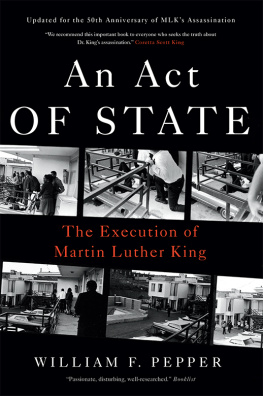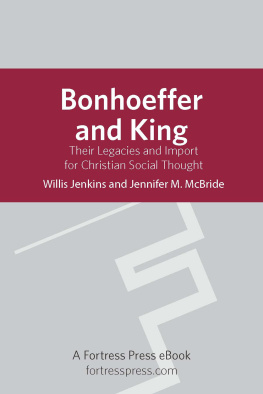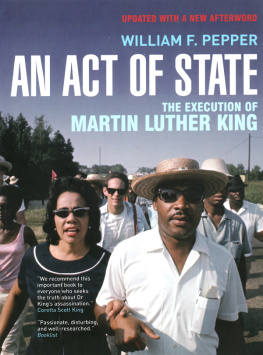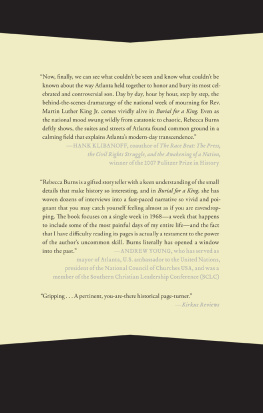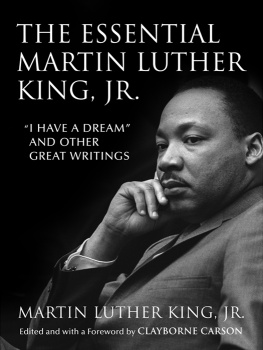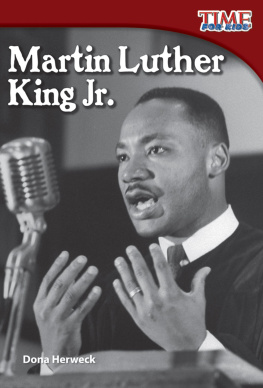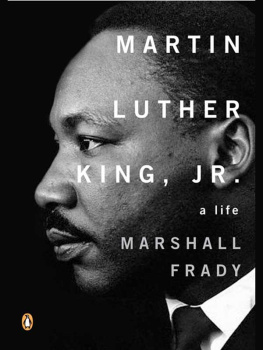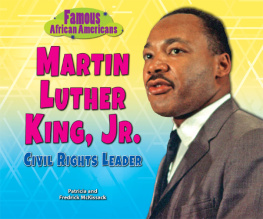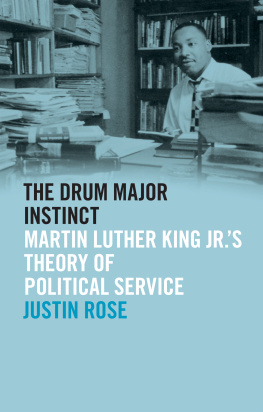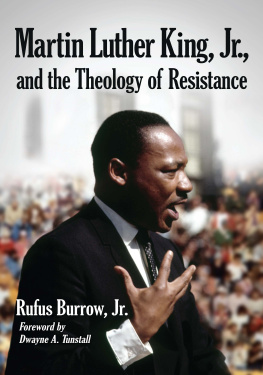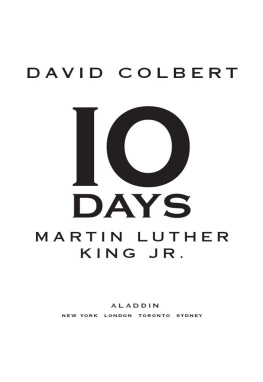Extremist for Love
Martin Luther King Jr., Man of Ideas and Nonviolent Social Action
Rufus Burrow Jr.
Fortress Press
Minneapolis
EXTREMIST FOR LOVE
Martin Luther King Jr., Man of Ideas and Nonviolent Social Action
Copyright 2014 Fortress Press. All rights reserved. Except for brief quotations in critical articles or reviews, no part of this book may be reproduced in any manner without prior written permission from the publisher. Visit http://www.augsburgfortress.org/copyrights/ or write to Permissions, Augsburg Fortress, Box 1209, Minneapolis, MN 55440.
Cover photo by Francis Miller / Time Life Pictures / Getty Images
Cover design: Laurie Ingram
Library of Congress Cataloging-in-Publication Data
Burrow, Rufus, 1951
Martin Luther King Jr., man of ideas and nonviolent social action / Rufus Burrow, Jr.
pages cm
Includes bibliographical references and index.
ISBN 978-1-4514-7020-8 (pbk. : alk. paper) ISBN 978-1-4514-8027-6 (ebook)
1. King, Martin Luther, Jr., 1929-1968. 2. King, Martin Luther, Jr., 1929-1968Political and social views. 3. NonviolenceUnited StatesHistory20th century. 4. Social actionUnited StatesHistory20th century. 5. African AmericansBiography. 6. Civil rights workersUnited StatesBiography. 7. BaptistsUnited StatesClergyBiography. 8. African AmericansCivil rightsHistory20th century. 9. Civil rights movementsUnited StatesHistory20th century. 10. United StatesRace relationsHistory20th centurySources. I. Title.
E185.97.K5B7995 2014
323.092dc23 [B] 2013034955
The paper used in this publication meets the minimum requirements of American National Standard for Information Sciences Permanence of Paper for Printed Library Materials, ANSI Z329.48-1984.
Manufactured in the U.S.A.
This book was produced using PressBooks.com.
To the memory of my son-in-love, Mr. David Todd Anderson (19662012), who had the audacity to believe that people whose humanity and dignity are systematically undermined by those who control and benefit mightily from unjust systems will overcome when they make up their minds to organize and take on the powers that be. He believed we can all be better than we are, but had an uncanny sense that we sometimes have to be pushed and prodded in this regard. In the best sense, and in the spirit of Martin Luther King Jr., David too was a man of ideas and ideals who had a deep faith in nonviolent direct action.
Contents
Martin Luther King Jr. was the most influential civil rights activist in the United States in the twentieth century. This point is well established in the growing body of scholarship on this phenomenal figure. But King was far more than a celebrated civil rights activist who gave dynamic speeches, led nonviolent demonstrations, and engaged in creative acts of civil disobedience. He was also a great thinker and man of ideas and letters, and the scope and vitality of his mind were such that he should be considered a part of that rich story that constitutes American intellectual history.
Rufus Burrow Jr. traces Kings metamorphosis as both an intellectual and activist, noting that in both categories his life was filled with incredible fulfillment and achievement. For Burrow, the arresting power of Kings ideas and idealism, and the ways in which this grounded his quest for social change, cast him in the image of the quintessential organic intellectual. Burrow teases out and analyzes the major features of Kings thought and intellectual sources and categories, while also linking his life to the broader cultural and political contexts that surrounded him. The finished product is a King who has been elusive and largely unknown to much of this nation and the world.
An Extremist for Love is a superb work in several respects. First, it is a vivid character assessment of a complex individual who thought and acted out of the proud heritage of his southern forefathers and mothers. Burrow reminds us that Kings thinking and activism were pervaded by the same visions that caught the imaginations of his grandparents and parents. The contention, then, is that the familial roots of Kings nonviolence and protest activities constitute the proper point of departure in any credible reconstruction of Kings public career as a thinker, idealist, and social activist.
Second, Burrow has given us perhaps the most extensive examination of Kings key ideas and concepts, such as the love and rationality of God, the dignity and worth of human personality, the essentiality of the love ethic, the communitarian nature of persons, and human freedom and sin. Careful attention is also devoted to Mohandas K. Gandhi, Walter Rauschenbusch, Reinhold Niebuhr, and other formal intellectual influences, which provided King with intellectual categories, interpretive models, and a conceptual framework to articulate many of these ideas. At the same time, Burrow reminds us of Kings amazing creativity in translating ideas into practical action and reality.
Third, Burrow highlights Kings connections and indebtedness to some of his most progressive-minded and socially active contemporaries, such as Vernon Johns, Jo Ann Robinson, James M. Lawson, Ella J. Baker, Bayard Rustin, and Glenn Smiley. Although these figures loomed large in Kings early development as a thinker and practitioner of creative nonviolent dissent and protest, they have, up to this point, received little attention in studies of King. Burrow corrects this pattern of neglect while establishing Kings rightful place in a movement that included numerous thinkers and courageous activists.
Finally, Burrow offers a fresh perspective on Kings legacy and what it means for our times, especially as we continue to grapple with the enduring problems of white supremacy, black intracommunal crime and violence, sexism, and other social ills. We are thus challenged to read and understand King not only in context, but also beyond context. Although much is revealed about Kings relevance and meaningfulness as a cultural and political icon for this age, Burrow also gives some indication as to why the intellectual legacy of King promises to be richer as time goes on. There is already a notable increase in interest in that part of Kings legacy.
But we are also confronted with caricatures of King that arise not only from a procrustean attitude toward figures of the past, but also from a lack of acquaintance with his words and ideas. Thus, it is not surprising that we are increasingly confronted with the image of the gentle, harmless southern black Baptist preacher who made love, nonviolence, and redemptive suffering the heart of the Christian faith. Images routinely fix themselves in the public consciousness, and this image of King is not easily shattered. In such a climate, Burrows book should be seen as part of a breakthrough toward a more enlightened understanding of King. With an admirable grasp of Kings thought and social activism in all of their depth and scope, Burrow has performed a significant measure of iconoclasm in the process of projecting a more accurate and balanced portrayal of King the man and his times.
Lewis V. Baldwin
Vanderbilt University
May 2013
So great a person was Martin Luther King Jr., and so profound were his contributions and legacy to this country and the world, that volumes of books have been and will be written on him. There was a time when I believed that the market could not contain more publications on King. I therefore concluded that there was nothing I could add that had not already been said or was being said about King and his civil rights ministry. However, when I began reading book after book after book on King, I discovered one of two things to be true: either no one was actually addressing the issues that most interested me or seemed most important to me, or no one approached a given topic on him in quite the way I would. In either case, I soon concluded that, owing to his monumental contributions toward the improvement of individuals and communities, areas of the life of Martin Luther King Jr. will continue to cry out for exploration.


